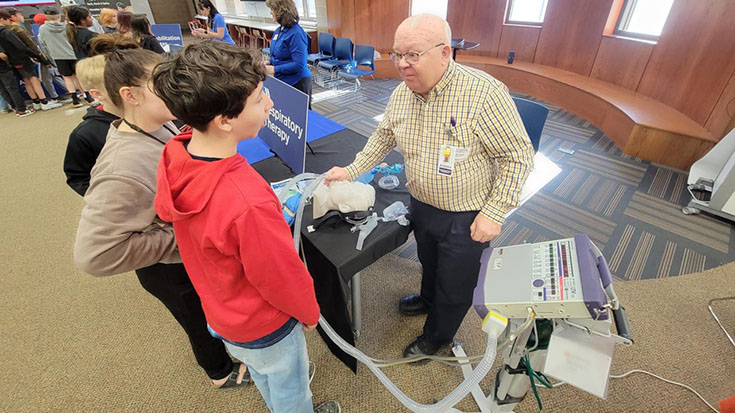
Budget cuts at work will likely happen at least once in your professional career. AARC Members Dana Evans, MHA, RRT, RRT-NPS, Cheryl A. Hoerr, MBA, RRT, CPFT, FAARC, and Kim Bennion, MsHS, RRT, CHC, share their tips and experiences to help RTs and managers survive and thrive through budget cuts.
Survival tips
- Make a plan: When building the budget each year, I always make note of areas I could trim if needed. This ensures that I am prepared for the conversation and have a thought-out approach to reducing spending. I find that a well-articulated plan goes a long way with the finance team. (Evans)
- Know your must-haves: I also make note of the areas I absolutely cannot trim and why. Again, thinking through my explanation while looking at the data is much easier than trying to remember what I was thinking later. (Evans)
- Keep patient care first: Obviously, large reductions are harder. In general, the first thing to go is money allocated to travel and meetings. This is followed by anything that isn’t absolutely needed for patient care or day-to-day operations. Education and attendance at educational events are such a sad thing to cut, but I would rather do that than end up eliminating positions. (Evans)
- Be efficient: Obviously, it’s better to avoid a budget cut in the first place. Managers can do this by ensuring their departments are running efficiently and effectively, that they aren’t overstaffing, and that they are using protocols to ensure that the right patients receive the right therapies at the right time. (Hoerr)
- Stay in the loop: By maintaining open communication with their up-line leadership, effective managers can ensure they are in the loop as to what is happening at the administrative level and will be able to anticipate a requested budget cut. The farther in advance a manager knows about a potential budget cut, the more time their department has to implement actions that may help avoid the cuts altogether. (Hoerr)
- Take note of non-billable services: Many of the services RTs provide are non-billable and aren’t part of the organization’s productivity management system. A manager may be able to mitigate budget cuts to the department by providing details of all the patient non-billable services, clinical support services and special projects provided by the RT department. Administration may re-think the budget cut when a manager can quantify the time and expense related to these services. (Hoerr)
- Track ALL you do: Accurate tracking of billable AND non-billable services RTs provide can prove of paramount importance. We track our activities in three main areas:
- Billable
- Non-revenue generating but related to a patient (e.g., called to bedside by nursing to assess but don’t have an order, the RN is just concerned)
- Non-revenue generating but NOT related to a patient (e.g., RTs on facility and system committees, teaching ACLS, NRP and PALS, educational in-services, attending and/or presenting at Grand Rounds).
When you track ALL you do even with just straight time taken, you’ll be surprised at how that adds up. (Bennion)
Managers lead the way
Evans explains that small cuts, which may happen often, may go unnoticed. It’s the large cuts, such as a position, that cause people to take notice and raise concern. Withholding information can lead people to fill in the gaps on their own, stirring inaccurate rumors.
“As is the case with any major initiative, transparency–as much as you can be–with a sincere explanation of what you know and what you don’t know is vital,” Evans said.
She believes that taking the time to answer team member “questions is important to show that you support them and recognize that this is a difficult time.”
“I don’t think you can over-communicate during times of uncertainty,” Evans said. “To be honest is to be kind.”
Evans also recommends that managers should prepare for a variety of responses.
“When sharing the budget cuts with staff, anticipate a wide range of responses,” Evans said. “Some may be scared, others may be angry. It is important to let them have their reaction. Stress response is variable.”
Hoerr encourages managers to look ahead.
“If a staff reduction is required, a manager must be wary of the consequences,” Hoerr said.
According to Hoerr, research shows that the staff who survive a layoff will have lower morale and employee engagement, decreased job satisfaction, and a decline in job performance (Sucher & Gupta).
“Effective change management practices must be used to guide the department through the downside of downsizing,” Hoerr said. “Managers must be able to transition the remaining staff from the current state to the desired future state by clearly stating the problem, establishing a fair transition process, developing the strategy and tactics to be used during the change, and identifying the future vision and expected outcomes of the change.”
When dealing with change, such as a freeze on capital projects, Hoerr suggests involving the staff.
“The manager can help the staff deal with their disappointment by being transparent about the situation and providing as many details as possible about the challenges the organization is facing,” Hoerr said. “This is also a good opportunity for the manager to involve staff in the restructuring process as they often have great ideas about implementing the changes and suggestions for cost reductions.”
First-hand experiences
“In my career as a manager I’ve been through several difficult budget-cutting situations,” Hoerr said. “In one organization we were not given any capital dollars for five years. This meant we had to make do with our current stockpile of equipment and, despite being extremely frustrated, the RTs became experts at equipment troubleshooting and maintenance.”
Hoerr continued to share that eventually the organization was sold to a larger system and all remaining staff members were offered positions with other hospitals in the system. Unfortunately, this scattered the colleagues making it difficult for paths to cross again.
“In another organization, I was challenged to defend my staffing levels,” Hoerr said. “Fortunately, I was a member of the AARC Benchmarking Program and was able to successfully use the data from my custom compare groups to highlight the fact that my department compared favorably in terms of volume per worked and paid hours. My administration was impressed with the data and I avoided the suggested staff reductions.”
Hoerr did endure a reduction to her operational budget, but said she was able to minimize the “effect on the RT department by involving the staff in an effort to minimize supply waste.”
“We were so successful that we actually posted a larger decrease in overall supplies used than was called for in our assigned budget!” Hoerr said.
Bennion shared her experience of when consultants came to her organization, suggesting RTs be cut.
“We pushed back after seeking how they arrived at such a decision,” Bennion said. “When we realized it was all based on CPT codes only, we pointed out that mechanical ventilation does not have a CPT code!”
Bennion and her team just underwent a major system reorganization.
“RT leaders were added, NOT cut,” Bennion said. “We felt well prepared to suggest and justify that and are so thankful our corporation listened.”
Final words of wisdom
Bennion and her team have created a Respiratory Care Documentation Standards Committee comprised of RT directors, managers, and RT staff.
“It is led by one of our RT managers,” Bennion said. “They have created a Documentation Standard Reference document and are creating an auditing/monitoring spreadsheet to capture and provide timely feedback for documentation and thus, billing errors.”
Hoerr reminds RTs and managers that communication is a key to success.
“Remaining silent on the subject of proposed budget cuts is definitely not the way to handle the issue,” Hoerr said. “The ‘grapevine’ is usually very effective in most organizations, and chances are good that the staff have already heard about potential cuts and are worried about their jobs. It is critically important to communicate well and often during any budget reductions. Even a suggestion that budget cuts are on the table will cause staff to worry and increase their stress levels. Keeping them informed of the latest news, and how suggested cuts will affect them, is key to keeping RTs satisfied with the organization, invested in their current position, and focused on providing the best care to their patients.”
Sucher, SJ, & Gupta,S (2018). Layoffs That Don’t Break Your Company. Harvard Business Review, (May-June issue). Retrieved from https://hbr.org/2018/05/layoffs-that-dont-break-your-company
Email newsroom@aarc.org with questions or comments, we’d love to hear from you.














